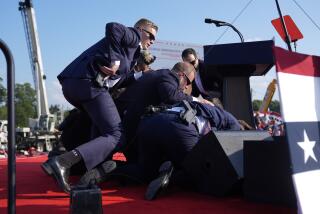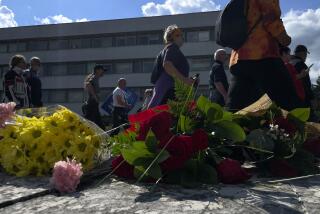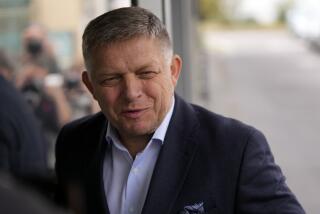Palme’s Assassin Eludes Manhunt : Witnesses’ Reports Vague, Motive Not Known; Rare Violence Stuns Swedes
- Share via
STOCKHOLM — Swedish police, engaged in the biggest manhunt in the nation’s history, admitted Saturday night that 24 hours after Prime Minister Olof Palme was killed on a Stockholm street, they had few hard clues to the assassin’s identity.
By late Saturday, police said they had interviewed about 10 people who were on or near Sveagagen, the busy thoroughfare where Palme was assassinated late Friday night.
A senior police official said: “The descriptions we have (of the killer) are vague; there isn’t much to go on.”
Authorities were unable even to suggest a motive for the killing. Palme, 59, was shot at close range as he walked from a movie with his wife, Lisbeth. The killing was the first political assassination in modern Swedish history, and in this country, which has seen little of the political violence that has become commonplace in other parts of the world, the murder has been met by stunned disbelief as well as by a national outpouring of grief.
sh ‘Never . . . in This Country’
King Carl XVI Gustav said: “I never thought that this kind of event would happen in this country.”
On Saturday, Palme’s 51-year-old deputy, Ingvar Carlsson, was named acting prime minister at an emergency meeting of the Cabinet. He also won the endorsement of the Social Democratic Party’s executive committee Saturday to assume the role of party chairman, a move that is expected to assure his being chosen as Palme’s full successor shortly after Parliament reconvenes from a winter recess March 10.
In the first daylight hours after Palme’s death, the country focused its attention on the search for the assassin. Accounts surrounding the killing varied widely. Through much of the day, police reported that Palme’s wife had recognized the assassin as someone she had seen before, but did not know who he was.
However, in an interview late Saturday, Lisbeth Palme, 55, was quoted as denying that she had seen her husband’s killer.
Order of Events Unclear
Some witnesses to the slaying said that Palme’s assassin engaged him briefly in conversation before shooting him. Others said that the assailant began firing as soon as he reached the prime minister. A single 9-millimeter bullet was found near the scene.
Security at airports and all border crossings was tightened as police searched for the assassin, described by witnesses as a dark-haired man between 30 and 45 years old and of average build. One witness described him as about 6 feet tall and wearing a blue ski jacket, dark trousers and a cap.
Although insisting that they were taking every clue or tip seriously, senior police officials appeared to play down reports that the killing was the work of an organized political group.
“There is nothing at this point to indicate political motives or that any political organization was behind this act,” Stockholm Police Chief Sune Sandstrom said at a news conference.
One report early Saturday, carried by the Swedish domestic news agency, TT, quoted police sources as saying that they were investigating Ustachi, a Croatian separatist movement with fascist sentiments, in connection with the assassination.
Palme Rejected Clemency
The group was said to have carried out the 1971 killing of the Yugoslav ambassador in Stockholm, and Palme last year rejected a clemency plea made on behalf of the man convicted of the murder.
Police also tended to dismiss a call made to a London news agency Saturday, claiming that the Holger Meins Commando, a West German terrorist group with links to the Baader-Meinhof gang of the early 1970s, had carried out the killing.
Sven-Ake Hjalmroth, head of the Swedish police unit that is somewhat akin to the U.S. Secret Service, and which is responsible for the security of important public figures, said that occasional threats had been made against the prime minister during his total of 11 years over two periods in the prime minister’s office.
Although he said that there were “very few periods” when Palme was not protected by bodyguards, he later conceded that there was no security guard of any kind with the prime minister after 11 a.m. Friday and that the VIP security unit was unaware that he had even gone to the movies.
‘Requested a Private Life’
“Olof Palme very firmly requested a private life and we respected that,” Hjalmroth said. “There was no special threat around him.”
(In Washington, Jack Taylor, a spokesman for the U.S. Secret Service, seemed genuinely startled when told that the Swedish prime minister had gone half a day without security protection. “Under the law,” he said, “the President of the United States is the only person the Secret Service is required to keep under protection at all times. We do have instances--visiting foreign dignitaries, for example--where individuals who have been receiving protection have asked that it be withdrawn, and we have cooperated. But with the President, we don’t provide part-time security.”)
Hjalmroth said that Palme often walked alone from the prime minister’s office to his Stockholm residence, but that an unescorted walk, such as the one he took Friday night, was unusual.
If Stockholm has a high crime area, it is the street along which Palme and his wife strolled after leaving a nearby movie theater. Nightclubs, restaurants and discotheques in the area generate late-night brawls and occasional muggings.
A Stockholm newspaper Saturday published the account of a 17-year-old student nurse who arrived at the scene moments after the shooting. She said that she tried to revive the stricken prime minister with mouth-to-mouth resuscitation but that he was already dead by the time a police ambulance arrived shortly after the shooting. She appeared to contradict earlier reports that he died on a hospital operating table.
Especially in Sweden
While loose security around a national leader is virtually unprecedented in any other large Western country, Sweden’s history seemed to indicate that if low-profile security is acceptable anywhere, it should be here.
Foreign Ministry officials, searching through the country’s archives, said that the last assassination of a national political figure in Sweden was in 1792, when a Swedish nobleman killed King Gustav III for usurping the rights of the country’s noble class.
The country’s long, successful policy of neutrality--which has kept it free from war for 170 years, its welfare state that eliminated many of the extremes between wealth and poverty, and a society remarkably free of violence--had led many Swedes to believe themselves somehow immune to the problems of political violence affecting the rest of the world.
In Sweden, prime ministers have been known to travel by bus and subway, and a key opposition leader commutes to work by bicycle.
Swedes encountered Saturday on the streets of Stockholm invariably began their comments about the killing with words similar to those of their king. A woman police officer guarding the barricades blocking the thoroughfare where Palme was slain shook her head slowly and repeated, “I can’t believe it has happened, that it has happened here.”
In the course of the day, thousands braved the bitter winter cold to stare from behind barricades at the patch of sidewalk where Palme fell. Some wept openly. Others appeared to have succeeded in convincing themselves that the killing had actually taken place.
Unanswerable Questions
Many brought clutches of flowers, which were collected by police at the barricades and taken to the spot where Palme died. By early afternoon, the sidewalk was covered with the public offerings. Nearby was a sign, asking the question, “Why does anyone murder a true democrat?”
So far, there has been no announcement of a date for Palme’s funeral, although a senior Social Democratic Party official indicated that it could be as late as March 15. “We have not been able to have much contact with the family on this matter so far today,” the official said. “We expect there will be an announcement (Sunday).”
Palme is regarded here as Sweden’s best-known prime minister internationally in this century--a global statesman, probably second among Swedes only to Dag Hammarskjold, the late U.N. Secretary General, who died in a plane crash in 1961 while on a peace mission to the Congo.
For much of his prime ministership, Palme had a foreign minister but conducted foreign policy in a personal, and often controversial, manner. More often than not, this policy gave a distinctly anti-American spin to Sweden’s neutrality.
In 1968, while he was still education minister, Palme gained international recognition by joining a senior North Vietnamese official in an anti-Vietnam War demonstration in Stockholm.
Tilted Neutrality?
During his first period as prime minister, Sweden became a haven for American draft evaders, and more recently, Palme seemed able to overlook the Soviet invasion of Afghanistan. Yet, he visited Nicaragua and condemned U.S. Central American policy.
In his later years, however, many political observers here felt that the anti-American tilt that won him domestic support during the Vietnam era had lost domestic support. The Swedish people seemed more concerned about the incursions of Soviet nuclear submarines into their territorial waters than potential U.S. threats in far-off places.
After a speech on May Day, 1984, in which he devoted 51 lines to criticizing U.S. Central American policy and only one line to the Soviet presence in Afghanistan, a leading independent Stockholm newspaper commented that the speech did not reflect the popular Swedish view of neutrality.
Because of Palme’s domination of Sweden’s foreign affairs, little is known about the views of his apparent successor, Carlsson, except that the two worked together since the late 1950s in the Social Democratic Party and, according the the party’s spokesman, Leif Gustafson, share common views.
But Carlsson’s experience has been almost exclusively on domestic issues.
More to Read
Sign up for Essential California
The most important California stories and recommendations in your inbox every morning.
You may occasionally receive promotional content from the Los Angeles Times.










